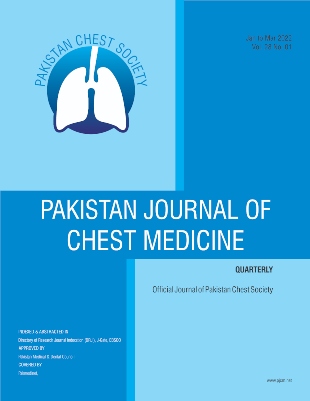Frequency of Obstructive Sleep Apnea in Patients of Chronic Obstructive Pulmonary Disease
Keywords:
COVID-19 Lockdown, Impact on Life, Adolescent, PakistanAbstract
Background: Obstructive sleep apnea (OSA), is a sleep-related disorder that is characterized by repeated upper airway collapse during sleep which leads to hindered airflow. It has been recognized as a common comorbidity in patients with COPD contributing to the severity of symptoms and COPD progression. Early identification and timely intervention will prevent complications and decrease morbidity and the rate of hospital admissions. Objective: The present study was conducted to determine the frequency of obstructive sleep apnea in patients with chronic obstructive pulmonary disease. Methodology: It was a descriptive cross-sectional study conducted at the Pulmonology Unit, Khyber Teaching Hospital Peshawar between September 18, 2018, to March 18, 2019. Overall, 88 COPD patients fulfilling the criteria were studied. Patients' demographic data was entered into a structured questionnaire. Each patient was assessed for BMI (Body Mass Index) and neck circumference. Later on, to eliminate bias all patients were subjected to the same level-3 polysomnography (a portable monitor which monitors at minimum the respiratory movements, oxygen saturation, airflow i.e. AHI and pulse rate. Each polysomnographic study was attended by the same sleep laboratory technician with adequate relevant experience. Those having an AHI of more than 5 were taken as OSA. Results: The mean age in years for this study was 55.7 with an SD (standard deviation) of ±7.82. A total of 88 patients were subjected to the study among which males were 36.4% and 63.6% were female. The mean BMI was 35.89 kg/m2 with a standard deviation ± 7.52. Moreover, 63.6% had obstructive sleep apnea while 36.4% didn't have obstructive sleep apnea. Conclusion: In conclusion, this study underscores the high prevalence of obstructive sleep apnea (OSA) among patientsdiagnosed with Chronic Obstructive Pulmonary Disease (COPD), with 63.6% of participants exhibiting OSA.References
Sutherland K, Cistulli PA. Recent advances in obstructive sleep apnea pathophysiology and treatment. Sleep Biol Rhythms.2015;13:26-40.
Vestbo J, Hurd SS, Agusti AG, Jones PW, VogelmeierC, Anyueto A, et al. Global strategy for the diagnosis, management and prevention of chronic obstructive pulmonary disease: GOLD executive summary. Am J Respir Crit Care Med. 2013;187:347-65.
McNicholas WT. Chronic obstructive pulmonary disease and obstructive sleep apnoea—the overlap syndrome. J Thorac Dis.2016;8(2):236-42.
Diaz-Guzman E, Mannino DM. Epidemiology and prevalence of chronic obstructive airway disease. Clin Chest Med.2014;35:7-16.
Senaratna CV, Perret JL, Lodge CJ, Lowe AJ, Campbell BE, Matheson MC, et al. Prevalence of obstructive sleep apnea in the general population: a systematic review, Sleep Med Rev. 2017;34:70-81.
Tageldin MA, Nafti S, Khan JA, Nejjari C, Beji M, Mahboub B, et al. Distribution of COPD-related symptoms in the Middle East and North Africa: results of the BREATHE study. Res pir Med.2012;106:25-32.
Heinzer R, Vat S, Marques-Vidal P. Prevalence of sleep-disordered breathing in the general population: the HypnoLaus study. Lancet Respir Med. 2015;3:310-8.
Soler X, Gaio E, Powell FL, Ramsdell JW, Loredo JS, Malhotra A, et al. High prevalence of obstructive sleep apnea in patients with moderate to severe chronic obstructive pulmonary disease. Ann Am Thorac Soc. 2015;12:1219–25.
Marin JM, Soriano JB, Carrizo SJ, Boldova A, Celli BR. Outcomes in patients with chronic obstructive pulmonary disease and obstructive sleep apnea: the overlap syndrome. Am J Respir Crit Care Med.2010;182:325-31.
Soler X, Gaio E, Powell FL, Ramsdell JW, Loredo JS, Malhotra A, et al. High prevalence of obstructive sleep apnea in patients with moderate to severe chronic obstructive pulmonary disease. Ann Am Thorac Soc.2015;12:1219–25.
Schreiber A, Cemmi F, Ambrosino N, Ceriana P, Lastoria C, Carlucci A. Prevalence and Predictors of Obstructive Sleep Apnea in Patients with Chronic Obstructive Pulmonary Disease Undergoing Inpatient Pulmonary Rehabilitation. Int J Chron Obstruct Pulmon Dis.2018;15(3):265- 70.
Turcani P, Skrickova J, Pavlik T, Janousova E, Orban M. The prevalence of obstructive sleep apnea in patients hospitalized for COPD exacerbation. Biomed Pap Med Fac Univ Palacky Olomouc Czech Repub.2015;159(3):422-8.
McNicholas WT. COPD-OSA overlap syndrome: evolving evidence regarding epidemiology, clinical
consequences, and management. Chest. 2017;152(6):1318-26.
Donovan LM, Feemster LC, Udris EM, Griffith MF, Spece LJ, Palen BN, et al. Poor outcomes among patients with chronic obstructive pulmonary disease with higher risk for undiagnosed obstructive sleep apnea in the LOTT cohort. J Clin Sleep Med. 2019;15(1):71-7.
Downloads
Published
How to Cite
Issue
Section
License
Copyright (c) 2022 Pakistan Journal of Chest Medicine

This work is licensed under a Creative Commons Attribution-NonCommercial 4.0 International License.








